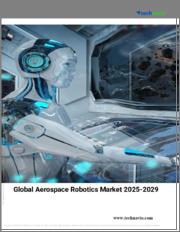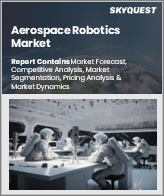
|
시장보고서
상품코드
1532467
항공우주 로봇 시장 : 용도별, 유형별, 기술별, 솔루션별, 예측(2024-2032년)Aerospace Robotics Market, By Application (Drilling, Welding, Painting, Inspection), By Type (Articulated, Cartesian), By Technology (Traditional, Collaborative), By Solution (Hardware, Software, Services) & Forecast, 2024 - 2032 |
||||||
항공우주 로봇 세계 시장 규모는 2024년부터 2032년까지 연평균 13% 성장할 것입니다.
항공우주 제조업체들이 작업자의 안전을 최우선시하는 가운데, 위험한 작업을 처리하기 위해 로봇을 도입하는 사례가 늘어나면서 인간이 위험한 환경에 노출될 기회를 줄이고 있습니다. 또한, 최신 항공기 부품은 복잡하고 정밀하기 때문에 고정밀하고 복잡한 조작이 가능한 고도의 로봇 시스템이 필요합니다. 이처럼 안전과 정밀도에 대한 수요 증가로 인해 로봇 공학의 채택이 증가하면서 항공우주 로봇 산업이 확대되고 있습니다.
예를 들어, 2024년 5월 두산로보틱스는 시카고에서 열린 Automate 2024에서 새로운 P-SERIES PRIME-SERIES 협동 로봇 P3020을 선보였습니다. 이 모델은 30kg의 중량과 80인치의 도달거리로 자동화 능력을 강화한 것이 특징입니다. 이번 개발은 항공우주 분야에서 더욱 강력하고 다재다능한 로봇 솔루션에 대한 추세를 강조하고 있으며, 업계의 진화하는 요구에 부응하기 위해 자동화 기술의 추가 채택과 기술 혁신을 촉진할 수 있습니다.
항공우주 로봇 시장은 용도, 유형, 기술, 솔루션, 지역별로 세분화되어 있습니다.
도장 분야는 항공기의 미관과 내구성을 향상시키는 데 중요한 역할을 하며 2032년까지 괄목할 만한 성장을 보일 것으로 예상됩니다. 자동 도장 시스템은 엄격한 항공우주 표준을 충족하는 데 필수적인 정확성, 효율성 및 일관성을 제공합니다. 항공우주 제조업체들이 고품질 마감과 인건비 절감을 점점 더 우선순위에 두면서 도장 공정을 간소화하는 로봇 솔루션이 인기를 끌고 있습니다. 이 부문의 성장을 주도하는 것은 복잡하고 빠른 도장 애플리케이션을 가능하게 하는 로봇 기술의 발전으로 항공우주 로봇 산업에서 상당한 점유율을 차지하고 있습니다.
다관절 로봇은 다재다능하고 복잡한 작업을 처리할 수 있는 고도의 능력으로 인해 2032년까지 급격한 성장이 예상됩니다. 다관절 로봇은 여러 자유도를 가지고 있어 항공기의 제한된 공간에서 조립, 검사 및 유지보수와 같은 복잡한 작업을 수행하는 데 이상적입니다. 다관절 로봇의 유연성과 정확성은 작업 효율성을 높여 최신 항공우주 애플리케이션에 필수적인 요소로 자리 잡았습니다. 항공우주 산업이 자동화를 계속 채택함에 따라 다관절 로봇에 대한 수요는 크게 증가할 것으로 예상됩니다.
유럽의 항공우주 로봇 시장 점유율은 강력한 항공우주 제조 기반과 첨단 기술 인프라로 인해 2024년부터 2032년까지 연평균 성장률(CAGR)이 두드러질 것으로 예상됩니다. 이 지역에서는 항공기 제조의 혁신과 높은 수준의 기술 혁신이 강조되고 있으며, 효율성과 정확성을 높이기 위해 로봇 도입이 촉진되고 있습니다. 프랑스, 독일, 영국 등 주요 항공우주 허브들은 경쟁력을 유지하기 위해 로봇 기술에 많은 투자를 하고 있습니다. 이러한 투자 확대와 기술 발전으로 유럽은 항공우주 로봇 산업에서 중요한 기여를 하고 있습니다.
목차
제1장 조사 방법과 조사 범위
제2장 주요 요약
제3장 업계 인사이트
- 생태계 분석
- 벤더 매트릭스
- 이익률 분석
- 테크놀러지와 혁신 전망
- 특허 분석
- 주요 뉴스와 대처
- 규제 상황
- 영향요인
- 성장 촉진요인
- 항공기 제조 공정의 자동화 수요 증가
- 비용 절감과 효율화 중시
- 복잡한 항공우주 작업에서 로봇 기술의 진보
- 제조의 정확도와 품질 관리에 대한 주목 상승
- 항공우주 사업의 노동력 부족과 안전성 우려에 대한 대응
- 업계의 잠재적 리스크와 과제
- 자동화 시스템의 사이버 보안 리스크에 대한 우려
- 로봇 기술 규제 준수 과제
- 성장 촉진요인
- 성장 가능성 분석
- Porters 분석
- PESTEL 분석
제4장 경쟁 상황
- 소개
- 기업 점유율 분석
- 경쟁 포지셔닝 매트릭스
- 전략 전망 매트릭스
제5장 시장 추정과 예측 : 용도별, 2021-2032년
- 주요 동향
- 천공
- 용접
- 도장
- 검사
- 기타
제6장 시장 추정과 예측 : 유형별, 2021-2032년
- 주요 동향
- 다관절형
- 직교형
- 기타
제7장 시장 추정과 예측 : 기술별, 2021-2032년
- 주요 동향
- 전통적
- 협업
제8장 시장 추정과 예측 : 솔루션별, 2021-2032년
- 주요 동향
- 하드웨어
- 소프트웨어
- 서비스
제9장 시장 추정과 예측 : 지역별, 2021-2032년
- 주요 동향
- 북미
- 미국
- 캐나다
- 유럽
- 영국
- 독일
- 프랑스
- 이탈리아
- 스페인
- 기타 유럽
- 아시아태평양
- 중국
- 인도
- 일본
- 한국
- 뉴질랜드
- 기타 아시아태평양
- 라틴아메리카
- 브라질
- 멕시코
- 기타 라틴아메리카
- 중동 및 아프리카
- UAE
- 남아프리카공화국
- 사우디아라비아
- 기타 중동 및 아프리카
제10장 기업 개요
- ABB
- AV&R
- Electroimpact Inc.
- Fanuc Corporation
- JH Robotics, Inc.
- KUKA AG
- Mitsubishi Electric Corporation
- OC Robotics
- Universal Robots A/S
- Yaskawa Electric Corporation
Global Aerospace Robotics Market size will expand at a 13% CAGR between 2024 and 2032, attributed to the focus on safety and the complexity of aircraft components. As aerospace manufacturers prioritize worker safety, robots are increasingly employed to handle hazardous tasks, reducing human exposure to dangerous environments. Furthermore, the intricate and precise nature of modern aircraft components necessitates advanced robotic systems capable of high precision and complex operations. This growing demand for both safety and precision fuels the adoption of robotics, thereby expanding the aerospace robotics industry.
For instance, in May 2024, Doosan Robotics introduced its new P-SERIES PRIME-SERIES collaborative robot, the P3020, at Automate 2024 in Chicago. This model features a 30 kg payload and an 80-inch reach, enhancing automation capabilities. This development highlights a trend towards more powerful and versatile robotic solutions in the aerospace sector, potentially driving further adoption and innovation in automation technologies to meet the industry's evolving needs.
The aerospace robotics market is fragmented based on application, type, technology, solution, and region.
The painting segment will garner remarkable gains through 2032, spurred by its critical role in enhancing aircraft aesthetics and durability. Automated painting systems offer precision, efficiency, and consistency, essential for meeting stringent aerospace standards. As aerospace manufacturers increasingly prioritize high-quality finishes and reduced labor costs, robotics solutions that streamline the painting process are gaining traction. This segment's growth is driven by advancements in robotic technology that enable complex, high-speed painting applications, thus capturing an ample share of the aerospace robotics industry.
The articulated segment will see a considerable surge by 2032, owing to its versatility and advanced capabilities in handling complex tasks. Articulated robots, with their multiple degrees of freedom, are ideal for performing intricate operations such as assembly, inspection, and maintenance within the confined spaces of aircraft. Their flexibility and precision enhance operational efficiency, making them essential for modern aerospace applications. As the industry continues to embrace automation, the demand for articulated robots will grow significantly.
Europe aerospace robotics market share will experience a notable CAGR from 2024 to 2032 due to its strong aerospace manufacturing base and advanced technological infrastructure. The region's emphasis on innovation and high standards in aircraft production drives the adoption of robotics to enhance efficiency and precision. Major aerospace hubs in countries like France, Germany, and the UK are investing heavily in robotic technologies to maintain competitive edges. This growing investment and technological advancement make Europe a crucial contributor to the aerospace robotics industry.
Table of Contents
Chapter 1 Methodology & Scope
- 1.1 Market scope & definition
- 1.2 Base estimates & calculations
- 1.3 Forecast calculation
- 1.4 Data sources
- 1.4.1 Primary
- 1.4.2 Secondary
- 1.4.2.1 Paid sources
- 1.4.2.2 Public sources
Chapter 2 Executive Summary
- 2.1 Aerospace robotics industry 360º synopsis, 2021 - 2032
- 2.2 Business trends
- 2.2.1 Total addressable market (TAM), 2024-2032
Chapter 3 Industry Insights
- 3.1 Industry ecosystem analysis
- 3.2 Vendor matrix
- 3.3 Profit margin analysis
- 3.4 Technology & innovation landscape
- 3.5 Patent analysis
- 3.6 Key news and initiatives
- 3.7 Regulatory landscape
- 3.8 Impact forces
- 3.8.1 Growth drivers
- 3.8.1.1 Increasing demand for automation in aircraft manufacturing processes
- 3.8.1.2 Emphasis on cost reduction and efficiency improvements.
- 3.8.1.3 Advancements in robotic technology for complex aerospace tasks
- 3.8.1.4 Rising focus on precision and quality control in production
- 3.8.1.5 Addressing labor shortages and safety concerns in aerospace operations
- 3.8.2 Industry pitfalls & challenges
- 3.8.2.1 Concerns over cybersecurity risks in automated systems
- 3.8.2.2 Challenges in ensuring regulatory compliance for robotic technologies
- 3.8.1 Growth drivers
- 3.9 Growth potential analysis
- 3.10 Porter's analysis
- 3.10.1 Supplier power
- 3.10.2 Buyer power
- 3.10.3 Threat of new entrants
- 3.10.4 Threat of substitutes
- 3.10.5 Industry rivalry
- 3.11 PESTEL analysis
Chapter 4 Competitive Landscape, 2023
- 4.1 Introduction
- 4.2 Company market share analysis
- 4.3 Competitive positioning matrix
- 4.4 Strategic outlook matrix
Chapter 5 Market Estimates & Forecast, By Application, 2021 - 2032 (USD Million)
- 5.1 Key trends
- 5.2 Drilling
- 5.3 Welding
- 5.4 Painting
- 5.5 Inspection
- 5.6 Others
Chapter 6 Market Estimates & Forecast, By Type, 2021 - 2032 (USD Million)
- 6.1 Key trends
- 6.2 Articulated
- 6.3 Cartesian
- 6.4 Others
Chapter 7 Market Estimates & Forecast, By Technology, 2021 - 2032 (USD Million)
- 7.1 Key trends
- 7.2 Traditional
- 7.3 Collaborative
Chapter 8 Market Estimates & Forecast, By Solution, 2021 - 2032 (USD Million)
- 8.1 Key trends
- 8.2 Hardware
- 8.3 Software
- 8.4 Services
Chapter 9 Market Estimates & Forecast, By Region, 2021 - 2032 (USD Million)
- 9.1 Key trends
- 9.2 North America
- 9.2.1 U.S.
- 9.2.2 Canada
- 9.3 Europe
- 9.3.1 UK
- 9.3.2 Germany
- 9.3.3 France
- 9.3.4 Italy
- 9.3.5 Spain
- 9.3.6 Rest of Europe
- 9.4 Asia Pacific
- 9.4.1 China
- 9.4.2 India
- 9.4.3 Japan
- 9.4.4 South Korea
- 9.4.5 ANZ
- 9.4.6 Rest of Asia Pacific
- 9.5 Latin America
- 9.5.1 Brazil
- 9.5.2 Mexico
- 9.5.3 Rest of Latin America
- 9.6 MEA
- 9.6.1 UAE
- 9.6.2 South Africa
- 9.6.3 Saudi Arabia
- 9.6.4 Rest of MEA
Chapter 10 Company Profiles
- 10.1 ABB
- 10.2 AV&R
- 10.3 Electroimpact Inc.
- 10.4 Fanuc Corporation
- 10.5 JH Robotics, Inc.
- 10.6 KUKA AG
- 10.7 Mitsubishi Electric Corporation
- 10.8 OC Robotics
- 10.9 Universal Robots A/S
- 10.10 Yaskawa Electric Corporation



















